Summary
-
1.
Dopamine and octopamine are applied iontophoretically to specific regions of the bee brain and the effects measured on evoked potentials recorded in the α-lobe of the mushroom bodies.
-
2.
Octopamine enhances the size of potentials evoked by light stimuli. Dopamine has no significant effect on light-evoked potentials.
-
3.
Both dopamine and octopamine reduce the size of potentials evoked by stimulation of the antennae with air or scent. In some animals however, octopamine, unlike dopamine, enhances olfactory responses.
-
4.
Differences between the effects of dopamine and octopamine on neural activity in the mushroom bodies of the bee brain may be related to the differences between the effects of these amines on behavioral responses in the bee reported in earlier studies (Mercer and Menzel 1982).
Similar content being viewed by others
Abbreviations
- AGT :
-
antenno-glomerular-tract
References
Dismukes K (1977) New look at the aminergic nervous system. Nature (London) 269:557–558
Dymond GR, Evans PD (1979) Biogenic amines in the nervous system of the cockroach,Periplaneta americana: association of octopamine with mushroom bodies and dorsal unpaired median (DUM) neurones. Insect Biochem 9:535–545
Elofsson R, Klemm N (1972) Monoamine-containing neurones in the optic ganglia of crustaceans and insects. Z Zellforsch Mikrosk Anat 133:475–499
Erber J, Masuhr T, Menzel R (1980) Localization of short-term memory in the brain of the bee (Apis mettifera). Physiol Entomol 5:343–358
Evans PD (1980a) Biogenic amines in the insect nervous system. Adv Insect Physiol 15:317–473
Evans PD (1980b) Octopamine receptors in insects. In: Sattelle DB, Hall LM, Hildebrand JG (ed) Receptors for Neurotransmitters, Hormones and Pheromones in Insects. Elsevier/North Holland, Amsterdam
Evans PD (1981) Multiple receptor types for octopamine in the locust. J Physiol (London) 318:99–122
Homberg U (1981) Ableitungen und Lucifer yellow Markierung von Neuronen des Tractus olfacto-globularis im Bienengehirn. Verh Dtsch Zool Ges 74:176
Kaulen P (1982) Feldpotentiale und eine Analyse der Stromquellendichte in den Corpora pedunculata vonApis mellifera. Diploma Thesis, Freie Universität Berlin, FRG
Kenyon FC (1896) The brain of the bee. A preliminary contribution to the morphology of the nervous system of the arthropoda. J Comp Neurol 6:133–210
Klemm N (1974) Vergleichend-histochemische Untersuchungen über die Verteilung monoamin-haltiger Strukturen im Oberschlundganglion von Angehörigen verschiedener Insekten-Ordnungen. Entomol Germ 1: 21–49
Klemm N (1976) Histochemistry of putative transmitter substances in the insect brain. Prog Neurobiol 7:99–169
Maynard DM (1956) Electrical activity in the cockroach cerebrum. Nature (London) 77:529–530
Maynard DM (1967) Organization of central ganglia. In: Wiersma CAG (ed) Invertebrate nervous systems. Chicago Univ Press, Chicago, pp 231–255
Menzel R, Erber J (1978) Learning and memory in bees. Sci Am 239:80–87
Menzel R, Erber J, Masuhr T (1974) Learning and memory in the honeybee. In: Barton Browne L (ed) Experimental analysis of insect behavior. Springer, Berlin Heidelberg New York, pp 195–217
Mercer AR, Menzel R (1982) The effects of biogenic amines on conditioned and unconditioned responses to olfactory stimuli in the honeybee,Apis mellifera. J Comp Physiol 145:363–368
Mobbs PG (1982) The brain of the honeybeeApis mellifera. I. The connections and spatial organization of the mushroom bodies. Philos Trans R Soc London Ser B 298:309–354
Murdock LL (1971) Catecholamines in arthropods: a review. Comp Gen Pharmacol 2:254–274
O'Shea M, Rowell CHF (1976) The neuronal basis of a sensory analyser, the acridid movement detector system. II. Response decrement, convergence, and the nature of the excitatory afferents to the fan-like dendrites of the LGMD. J Exp Biol 65:289–308
Pichon Y (1974) The pharmacology of the insect nervous system. In: Rockstein M (ed) The physiology of insecta. Vol 4, 2nd ed., Academic Press, New York London, pp 101–174
Robertson HA (1976) Octopamine, dopamine and noradrenaline content of the brain of the locust,Schistocerca gregaria. Experientia 32:552–553
Rowell CHF, Horn G (1968) Distribution and arousal in the response of single nerve cells in an insect brain. J Exp Biol 49:171–183
Schürmann FW (1970) Über die Struktur der Pilzkörper des Insektengehirns. I. Synapsen im Pedunculus. Z Zellforsch Mikrosk Anat 103:365–381
Schürmann FW (1972) Über die Struktur der Pilzkörper des Insektengehirns. II. Synaptische Schaltungen im Alpha-Lobus des HeimchensAcheta domestica L. Z Zellforsch Mikrosk Anat 127:240–257
Steiner FA, Pieri L (1969) Comparative microelectrophoretic studies of invertebrate and vertebrate neurones. Prog Brain Res 31:191–199
Author information
Authors and Affiliations
Rights and permissions
About this article
Cite this article
Mercer, A.R., Erber, J. The effects of amines on evoked potentials recorded in the mushroom bodies of the bee brain. J. Comp. Physiol. 151, 469–476 (1983). https://doi.org/10.1007/BF00605463
Accepted:
Issue Date:
DOI: https://doi.org/10.1007/BF00605463




